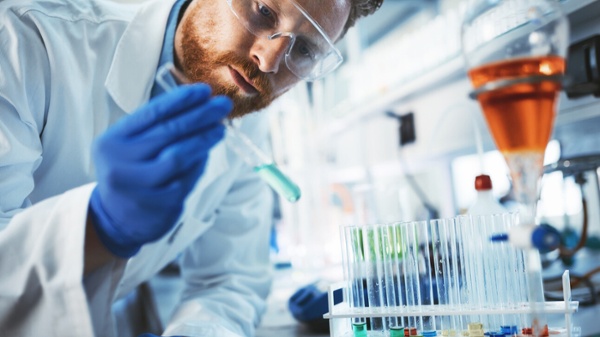A common hazard found in laboratories is the risks associated with dangerous chemicals. There are 9 classes of dangerous goods — with each class posing specific hazards to people, property and the environment. To protect yourself and others from these dangerous chemicals, it’s important that you safely store chemicals in the laboratory. This post details these Standards and explains how laboratory technicians can ensure substances are stored safely by taking a systematic approach to controlling hazards — as per the requirements of the Australian Standards.
Storing Chemicals in Laboratories
The Australian Standards are documents that define the specifications, procedures and guidelines for the storage and handling of dangerous chemicals. The specific requirements for Safety In Laboratories Australian Standard are found in AS 2243.1.
This Standard outlines the requirements for matters relating to operational safety when storing dangerous chemicals. For matters relating to the design and construction of chemical storage cabinets, the specific standard for the class of dangerous goods being stored must be consulted. For example, AS 1940 must be consulted for specific detail relating to the design and construction of cabinets used to store Class 3 - Flammable Liquids.
REMEMBER: Safe chemical storage will help mitigate the risks associated with your laboratory chemicals, including incidents such as fires and explosions, or health hazards such as asphyxiation and acid burns.
Responsibilities of Laboratory Technicians
In line with WHS Regulations, it’s the responsibility of every employer and employee to ensure that a safe working environment is created and maintained.
When working with hazardous chemicals and multiple classes of dangerous goods, laboratory technicians must follow the requirements to ensure that any hazards are controlled. This relates to all aspects of the job including laboratory techniques, the handling of substances, and making sure that chemicals are stored safely.

Laboratory technicians must ensure a safe working environment to mitigate chemical risk.
Hazard Identification Information
It’s important to be aware of the risks associated with the dangerous chemicals that are stored in the lab. This can be achieved by displaying clear hazard identification information.
The Standard sets out the requirements for Hazard Identification Information in laboratories, which states that clear DG signage must be placed on all doors entering the laboratory and on cabinets being used for the storage of dangerous chemicals.
Laboratory Cupboards
The Australian Standard gives you the provision to store hazardous chemicals in laboratory cupboards if they meet certain requirements.
These requirements for laboratory cupboards explain that the equipment must be:
- Constructed from a material that is compatible with the chemical being stored.
- Not constructed from particle board.
- Equipped with spill trays.
- Offer adequate ventilation if it’s required as an essential risk control measure, ie. where flammable, volatile, toxic or corrosive vapours are present.
Using Chemical Storage Cabinets in the Lab
However, we strongly recommend that you do not use a cupboard for the storage of hazardous chemicals in the laboratory. For safe chemical storage, laboratory technicians should use equipment that minimises the specific risks associated with the hazardous chemicals and dangerous goods.
The required features of a cabinet for laboratory chemical storage include:
- Constructed from non-combustible material. This ensures that the contents inside the cabinet are insulated in the event of a fire.
- Coated or constructed from a non-corrosive material. This ensures that the structural integrity of the facility is not destroyed from corrosive chemicals.
- Vent ports that allow a compliant ventilation system to be installed on the cabinet to keep the vapours inside the facility below the workplace exposure standards.
- A sump at the bottom of the facility to contain any spills that may occur inside the facility.
- Self-closing self-latching doors. This ensures that the hazardous vapors inside the facility don’t fill the laboratory.
Laboratory cupboards do not have these important features. This makes them an unsafe and dangerous method for storing hazardous chemicals.
A chemical storage cabinet that has been manufactured in full conformance to the relevant Australian Standard will protect the dangerous chemicals inside the cabinet from damage and contamination. In the event of a fire, a chemical storage cabinet will provide at least 10 minutes for people working in the lab to escape, or to use firefighting equipment to suppress the fire.
REMEMBER: You must first identify the classification for the chemical that you are seeking to store. This information can be found on the safety data sheet.
Chemical Cabinet Ventilation
Ventilation of most chemical storage cabinets isn’t required unless it’s part of an essential risk control measure – or it’s dictated by the relevant Australian Standard. Mandatory ventilation is required for the storage of oxidising agents or organic peroxides.
If the cabinet is storing substances that release volatile, extremely toxic or corrosive vapours, a compliant ventilation system will be required.
A compliant ventilation system will remove the vapours inside the cabinet and disperse them into the outside atmosphere. The dispersing location should be away from any ignitions sources and places where people congregate. The ventilation system shouldn’t substitute a vapour-tight chemical storage cabinet. The technical design of the ventilations system depends on the specific nature of the vapour that is being removed. In all cases the ventilation system must be vapour-tight and not allow vapours to escape into the lab.
Cabinet Location
For safe chemical storage, it’s also important to position cabinets in a safe location. All chemical storage cabinets, regardless of their size or type must not be stacked on top of one another. Cabinets containing dangerous chemicals should not be placed under stairs or corridors. To ensure that everyone working in the lab can safely escape in the event of a fire, chemical storage cabinets must not be placed in a position where they will jeopardise an emergency escape route. To ensure that cabinets don’t hinder emergency escape routes they must be positioned at least 3m from emergency escape doors.
To minimise the risk of fires, chemical storage cabinets must be segregated from ignition sources. If a cabinet is storing flammable liquids or substances that emit flammable vapours, it must be positioned at least 3 metres from all ignition sources. Ceiling lights are an exception to this requirement.
Learning More About Storing Chemicals as a Laboratory Assistant
If you are storing dangerous chemicals in your lab, it’s important that you store them in full conformance to the Australian Standards. This includes safe segregation of incompatible classes of dangerous goods. To learn more about the management of hazardous chemicals in the lab – or any workplace – access your free copy of our handy guide. We’ll take you through all the essential considerations so you can create a safer workplace.
Joining the team as a Dangerous Goods Storage Consultant, Melissa Hampton became Storemasta's Marketing Manager in late 2021. With extensive knowledge and experience in chemical compliance, Melissa is responsible for leading the Marketing team and helping shape their marketing strategy. In her spare time, you can find Melissa hiking, swimming and enjoying the great outdoors in beautiful north-west Tasmania.

